

Imperial Home Page -> Repair -> Body & Paint -> Paint & Body 101 -> Part 6
Week of January 26, 2003
Prime, Block sand, detail engine
Monday the 26'th time to prime. Temperature was supposed to be near 50 so I fired up the heater and heated everything up to 70 degrees while I prepared for the primer. I have this BIG roll of thin plastic that was in the trash at work. I use it to cover windows and anything else I don't want paint to get on. I run a line of tape around the border of the window, lay the plastic down, trim to fit, and tape it down with the tape on both the border tape and the plastic, pulling taut.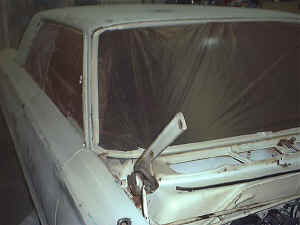 Ready for primer after a wipe down with wax and grease remover and a wipe with a
tack cloth.
Ready for primer after a wipe down with wax and grease remover and a wipe with a
tack cloth.
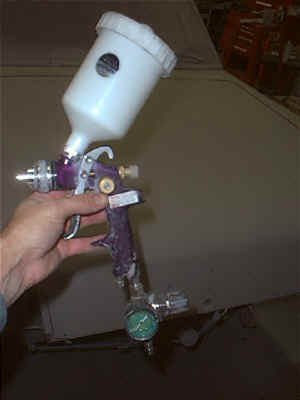 Here is my paint gun, it is a Harbor Freight (read that Hong Kong Fooey)
knockoff of a name brand. It works great. It is the new HVLP style
(High Volume Low Pressure) and I really like it. HVLP has MUCH less
overspray and therefore uses a ton less material. It also seems to flow on
better. This is also my a gravity feed gun instead of the traditional siphon
type. I always thought they high can would make it awkward but it feels
perfectly balanced and very comfortable. Plus there are no drips because
the can is not pressurized. Some of my paint buddies talk about their
DeVibliss and Sata, etc but they use them all day every day. My paint
store guy (James at Reid Color) says these are just as good. Never used a
good one but these work fine. I bought a spare the other day when they
were on sale for 45 bucks.
Here is my paint gun, it is a Harbor Freight (read that Hong Kong Fooey)
knockoff of a name brand. It works great. It is the new HVLP style
(High Volume Low Pressure) and I really like it. HVLP has MUCH less
overspray and therefore uses a ton less material. It also seems to flow on
better. This is also my a gravity feed gun instead of the traditional siphon
type. I always thought they high can would make it awkward but it feels
perfectly balanced and very comfortable. Plus there are no drips because
the can is not pressurized. Some of my paint buddies talk about their
DeVibliss and Sata, etc but they use them all day every day. My paint
store guy (James at Reid Color) says these are just as good. Never used a
good one but these work fine. I bought a spare the other day when they
were on sale for 45 bucks.
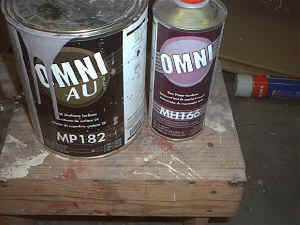 I'm using the Omni brand of PPG paints. This is their cheap product but
again James, recommends it and says it is outselling PPG 2 to 1 and is about 1/3
the price. The primer is catalyzed and you have to wear a good mask
because of the isocynates. You also need to be sure and wear long sleeves,
rubber gloves, etc, and make sure all exposed skin is covered. A fresh air
respirator is recommended although a lot of people use charcoal filters. I
use an Israeli gas mask that is full face. My painter guys tell me this is
not a good idea but I figure if it will stop nerve gas it should stop isocynates.
If I die before I finish this I was wrong. Isos are nasty things.
They are cumulative and build up in your body until one day you just can't
breathe.
I'm using the Omni brand of PPG paints. This is their cheap product but
again James, recommends it and says it is outselling PPG 2 to 1 and is about 1/3
the price. The primer is catalyzed and you have to wear a good mask
because of the isocynates. You also need to be sure and wear long sleeves,
rubber gloves, etc, and make sure all exposed skin is covered. A fresh air
respirator is recommended although a lot of people use charcoal filters. I
use an Israeli gas mask that is full face. My painter guys tell me this is
not a good idea but I figure if it will stop nerve gas it should stop isocynates.
If I die before I finish this I was wrong. Isos are nasty things.
They are cumulative and build up in your body until one day you just can't
breathe.
Obviously this is serious stuff and I do not take it lightly. I also make sure to stand upwind in a well ventilated space. The HVLP really cuts down on the overspray which helps also.
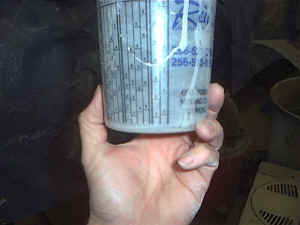 Here is a neat gadget I picked up at the paint store. It is a mixing
cup. Each can of paint is marked with the porportions of paint, hardner,
filler, etc. For instance, the primer is 4 to 1. All you have to do
is find the appropriate column, pour in the paint to whatever amount you need,
and the cup tells you how much of the next ingredient is needed. Pretty
slick!
Here is a neat gadget I picked up at the paint store. It is a mixing
cup. Each can of paint is marked with the porportions of paint, hardner,
filler, etc. For instance, the primer is 4 to 1. All you have to do
is find the appropriate column, pour in the paint to whatever amount you need,
and the cup tells you how much of the next ingredient is needed. Pretty
slick!
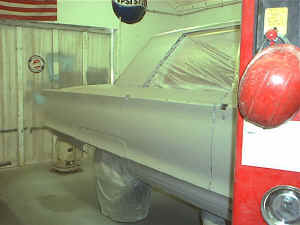
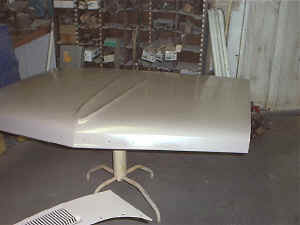 It took about 2 hours to spray two good coats of urethane primer. Working
alone is much more difficult than having a helper. Robert will be
back for the color shoot.
It took about 2 hours to spray two good coats of urethane primer. Working
alone is much more difficult than having a helper. Robert will be
back for the color shoot.
Time to run some errands (4 hours on Monday)
Tuesday - Sand time
This is without a doubt the most boring, dull, monotonous, and important part of the paint job. Anything you don't get right now WILL show up in the final result. Been there, done that, am going to try and make this one PERFECT! Notice the word try.
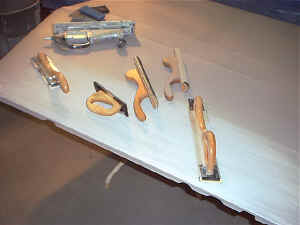 Here are some tools of the trade. The straight line sander with a variety
of grits from 180 to 240 will do the first cut on flat panels. After that
it is time for hand work and I'll use a collection of board sanders some flat
and some with curved bottoms.
Here are some tools of the trade. The straight line sander with a variety
of grits from 180 to 240 will do the first cut on flat panels. After that
it is time for hand work and I'll use a collection of board sanders some flat
and some with curved bottoms. 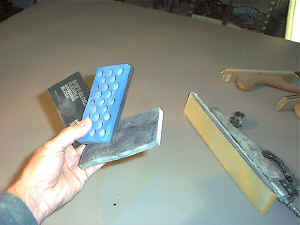 For tight work, I'll use some hand sanding pads that range from stiff (the one
in the middle) to just a piece of foam (on the right)
For tight work, I'll use some hand sanding pads that range from stiff (the one
in the middle) to just a piece of foam (on the right)
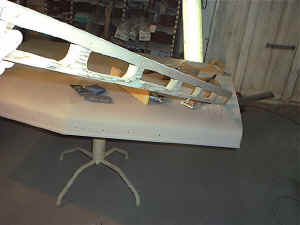 For LONG flat spots, I sometimes use this 5' long sander I made when I was
trying to get the 57 Imperial straight. If you want it straight, you have
to be able to find the high and low spots and not just ride the waves with
shorter sanders.
For LONG flat spots, I sometimes use this 5' long sander I made when I was
trying to get the 57 Imperial straight. If you want it straight, you have
to be able to find the high and low spots and not just ride the waves with
shorter sanders. 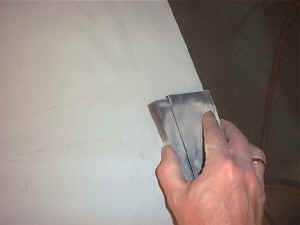
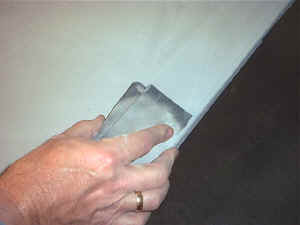 Here is a trick for hand sanding. You need to be very careful not to cut
through the primer on counter lines and edges. One trick is to let your fingers
or thumb ride along the edge or contour line and keep the pad off it slightly.
Here is a trick for hand sanding. You need to be very careful not to cut
through the primer on counter lines and edges. One trick is to let your fingers
or thumb ride along the edge or contour line and keep the pad off it slightly.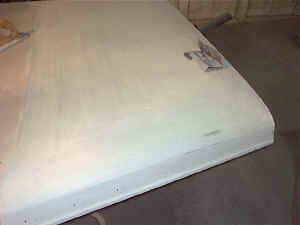 In this shout you can see a spot where I cut through the primer. That's ok
because it is a slight high spot. I'll hit it with another splash of
primer
In this shout you can see a spot where I cut through the primer. That's ok
because it is a slight high spot. I'll hit it with another splash of
primer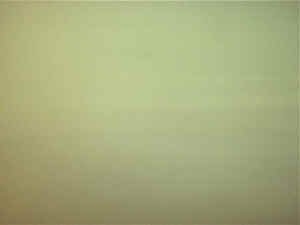 As you are sanding the primer, low spots will show up even without a guide coat
as the original, not as dull color. In this shot in the exact center about
1/4 of the way down from the top, you can detect a dark spot. That is low
and will need to come up with a little spot of primer.
As you are sanding the primer, low spots will show up even without a guide coat
as the original, not as dull color. In this shot in the exact center about
1/4 of the way down from the top, you can detect a dark spot. That is low
and will need to come up with a little spot of primer.
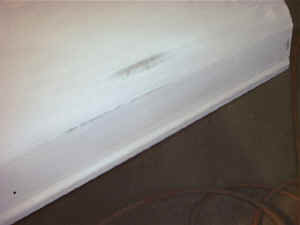 Close up of where I went through the primer.
Close up of where I went through the primer.
I was about 1/2 way through the hood and my youngest son came by and while I had a strong back and weak mind we flipped the hood over so I could put some color on it. I want to have the engine compartment finished before I do the exterior. With metallic paint, it's important to keep the paint gun flow in the right direction and in the same paint can or the difference will show so I want the hood on the car.
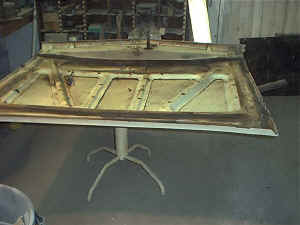
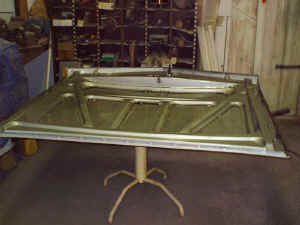 After a little cleaning, the urethane color sprayed on nice.
After a little cleaning, the urethane color sprayed on nice.
Hadn't planned on doing it today but got in the mood to go ahead and detail the engine compartment. The engine is the wrong color and the firewall and inner fenders are badly stained. As I started, one thing led to another and before I knew it, EVERYTHING was off the car except the AC compressor. I even pulled the wiring harness and radiator. The radiator trained for an hour it seemed like. Don't forget to plug the transmission cooler line or it will drip all over.
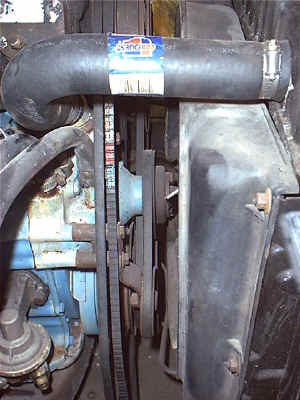 Interesting thing I noticed while pulling stuff is that both the fan belt idler
and the power steering pump are out of line with the belts. You can see
the idler kinked in this photo. I'll have to fix that when I put it back
together.
Interesting thing I noticed while pulling stuff is that both the fan belt idler
and the power steering pump are out of line with the belts. You can see
the idler kinked in this photo. I'll have to fix that when I put it back
together.
Shi* happens. In this case, my digital camera bit the dust. I lost quite a few photos of the engine compartment process but here is the result. The color on the inner fenders looks gold instead of silver but it must be the florescence light because it's silver. It's going to look nice.
Wednesday was 6 hours. Thursday was about 1 hour because all I did was chase new cameras and getting it set up. All I did was airbrush a few spots where the color did not cover right and paint the accessories black. I'll put it together tomorrow hopefully and get back to sanding.
Couple people have asked about my English Wheel. I'll do a thing about metalshaping on patch panels when I get through with the 300 but for now, here is the business end of an English Wheel (or Ewheel). There are several different lower wheels (anvil) each with different radius and a corresponding flat spot. The one shown is a 12" radius with a 1/8" flat spot. When the anvil is cranked up against the top wheel with a screw adjuster and the metal is rolled between them, it is stretched and begins to take a shape. Using different anvils, pressure, and number of passes, you can create very complicated shapes. It's actually faster if you beat the metal with a round nose mallet on a sandbag into rough shape and use the wheel to smooth out the lumps. It is really amazing to watch the lumps turn into a smooth shape in just a few passes.

This page was last updated November 10, 2003. Send us your feedback, and come join the Imperial Mailing List - Online Car Club